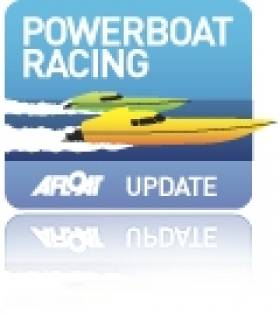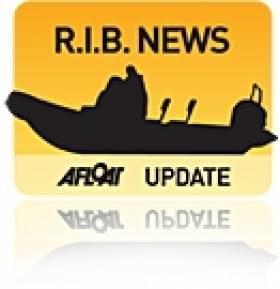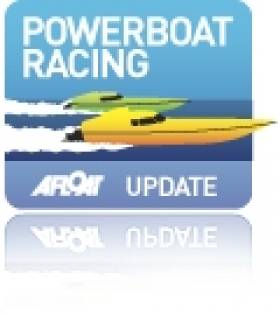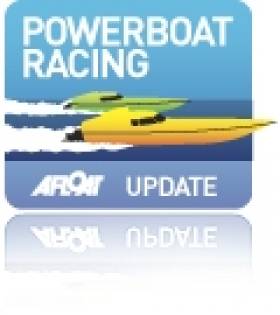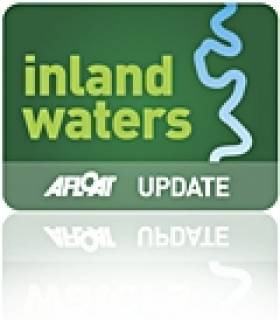Displaying items by tag: Powerboat
P750 Thunder Action on Limerick Waters
#P750 – Last Sunday saw the start of a fresh new format for Irish powerboating when the opening round of the P750 Thundercat National Championships hit the water in the very heart of Limerick as part of the popular Riverfest celebrations.
Excellent weather drew thousands of spectators to the quays and they weren't to be disappointed. Race 1 saw the pre-race favourite 'Batman & Robin' (Clifden's Colin Snow & Conor Mullally) take a convincing win, but their afternoon changed dramatically when their prop became fouled with fishing line at the start of Race 2. That left a three-way fight between 'Ardmore Adventures', 'Aptriva' and 'The Gym' over the remaining two races and while Batman & Robin were able to carve their way back through most of the fleet, The Gym's Colin Gaffney and Sara-Jane Allen of Dublin ended up taking the spoils among a competitive 8-boat fleet.
While the Thundercat powerboats are more at home racing and jumping in heavy surf all around the World, their speed and turning ability makes them ideal for a city centre race - something which clearly proved a winner for crews and spectators yesterday.
Final Results:
1. The Gym - Colin Gaffney & Sara-Jane Allen (Dublin) - 20 points
2. Ardmore Adventures - Ronan O'Connor & Andrew O'Leary (Ardmore) - 17 points
3. Batman & Robin - Colin Snow & Conor Mullally (Clifden) - 15 points
4. Aptriva - Peter Sweeney & Chris Gleeson (Cork) - 13 points
5. Adventure Training Ireland - Donnchadh Mac Cobb & Carmel Guilfoyle (Dublin) - 11 points
6. Team Riverfest - Darragh & Gearoid Quaid (Limerick) - 10 points
7. Double Trouble - Aileen Mann & Temba Jere (Kinsale) - 9 points
8. Clifden Thunderkittens - Kathriona McHugh & Caitriona Staunton (Clifden) - 8 points
New Powerboat School for Dun Laoghaire
#POWERBOAT – Irish National Sailing School (INSS) and Club have announced a new venture in to powerboating. A sister company, the Irish National Powerboat School is providing 'powerboat courses suitable for all levels from novice powerboaters to experienced hands'.
The new company provides courses to a National Powerboat Certificate (Level 2), First Aid & VHF, the Interantional Certificate of Competency as well as 'high octane' powerboat trips around Dublin Bay.
The INSS was established in 1972 and is based at the West Pier, Dun Laoghaire.
The INPS website is here
New Yachts and Motorboats Added to Afloat's Boats for Sale Site
#BOATS FOR SALE – A 1995 Nauticat 32 that the broker says is 'a really good example of this quality pilot-house cruising yacht', a 1984 Jeanneau Arcadia 29 designed by Tony Castro, a 2005 Beneteau First 36.7 with a rig replacement and a Princess 415 motorboat that 'must be sold' have been added to the Afloat Boats for sale site over the last 24 hours. Check out over 286 boats for sale here
Lakeside Marina is Venue for First Powerboat Run of 2012
#POWERBOAT – Lakeside Marina on the river Shannon is the venue for first power boat event of the season and if it's a chilly one there's a good chance the event will end in Sean's Bar for a 'warmer upper'. That's according to organiser Cormac Smith who intends to run the first Powerboat run of the year 201 on February 11th at Lakeside Marina in Athlone.
The aim is to launch boats at 10.45am but plans will be very dependent on weather and size/ type of boats that turn up. All welcome. The schedule is as follows:
Meeting @ Lakeside Marina From 10.30
Launch ing from 10.45
Run up or down the lake (weather dependent)
Lunch In Lecarrow or Hodson Bay Hotel
Return trip on Lake
Recover Boats 4.30-5.00 ish
Powerboat Racing's 'America's Cup' Returns to Cork
Plans are afoot to bring powerboat racing's Harmsworth Trophy event to Cork in 2014 - over 100 years since Cork Harbour hosted the first ever edition of the race. SCROLL DOWN FOR ARCHIVE Footage.
Regarded as the powerboat version of yachting's America's Cup, the first Harmsworth Trophy was won in July 1903 by Napier, which was allegedly piloted by women's world land speed record holder Dorothy Lewitt.
According to the Tom MacSweeney column in the Evening Echo, a consortium is hard at work to bring the race back to its birthplace - coinciding with the Round Ireland Powerboat Race, which will also be held out of Cork in 2014.
Denis Dillon of the Irish Sailing Association commented: "There is a group of Cork enthusiasts interested and is trying to put a consortium together that would also bring back one of the original 1903 boats still is existance which is in the USA.
"It came first in its class and second overall in the race in 1903 and they hope to bring it back for the 2014 race."
Two Rescued in Galway Bay After Powerboat Breakdown
BreakingNews.ie reports that a Galway lifeboat rescued two men from a powerboat in Galway Bay yesterday afternoon.
The men were found drifting close to rocks after their 19-foot broke down south of New Harbour shortly after lunchtime.
The Irish Coast Guard Rescue Helicopter and the RNLI Lifeboat responded in minutes to the men's distress call.
City Powerboat School on the Market
Due to an opportunity for its owners overseas Dublin City's only powerboat training school, City Powerboat School is on the market. The Irish Sailing Association recognised training establishment is advertised in next week's edition of Afloat magazine. The school operates in the 'highly visible' River Liffey area. School principal Felix Finlay says 'the position of the school in Dublin City has attracted many enquiries, for not only powerboat training courses, but sail training, tourism activities, and educational opportunities'. More here.
Irish Powerboat Racers Take to World Stage
Irish powerboat racers have taken to the world stage in the southern hemisphere for the first time. (SCROLL DOWN FOR PHOTOS)
Keith Plummer, Lee Casey and Colin Gaffney from Dublin, all members of the Buccaneer Powerboat Club and Sean Dillon and Gary Hogg from Clare, members of the Irish Offshore Powerboat Racing Club took part in the UIM P750 World Championships South Africa last week.
On the ground the reports were that even though the Irish competitors had their mechanical setbacks they kept pushing hard. When it came to the rough stuff in the surf they really shined, gaining a lot of respect from their fellow competitors.
Sean Dillon & Gary Hogg had two wins and a second in the surf discipline and finished fourth overall in the championships. Mechanical setbacks denied Colin Gaffney and co-driver Bongani Ndesi, a world Championship medal to accompany his European Championship medal won at the UIM P750 European Championship at Killaloe in October.
All five have reported that it was a great experience and that taking part showed them what a wonderful sport this is and being part of the UIM family. They all said how proud they were to be Irish and the first competitors with an ISA Powerboat Racing Licence to Race in South Africa.
The P750 class has gone from strength to strength in Ireland and 2010 saw a well-supported national Championship, the P750 Europeans being held in Ireland and Irish Competitors competing in the World Championships.
Pictures below by Paul Bedford/www.actionimages.co.zaColin Gaffney Boat No 21, Keith Plummer and Lee Casey From Dublin Boat No 22, Sean Dillon and Gary Hogg from Clare Boat No 49. Sean and Gary were the top Irish team being placed fourth.
New Powerboat Branch Launched by IWAI
To raise the profile of Irish powerboating at a time when power-boaters are the most likely target for regulation the Inland Waterways Association of Ireland (IWAI) has formed a new power-boating branch. It will be the twenty first branch of the association.
The move mirrors a similar adoption of powerboat interests by the Irish Sailing Association who appointed a powerboat officer to promote the interests of this sector of the sport.
The objects and ethos of this new IWAI branch is to promote the use of the inland waterways to the many people who use Powerboats, RIBs, PWCs and Sports boats from Trailers and Marinas anywhere on the island of Ireland and indeed further afield.
The first meeting will take place in Cox's of Dromod, Co Leitrim on Fri 21st. Jan at 7.30 PM, a committee will be elected, a calendar of events will be approved, but most importantly, says IWAI President Paul Garland "we need founding members, like minded people to help develop this new Branch Single Membership is Euro44 & family is Euro 55 per annum and all of the privileges of IWAI membership apply with quarterly magazines over 200 organised events, training, funding, but most importantly lobby power with four thousand members our voice has become known as the voice of the waterways and with increasing legislation we have found the voice of powerboat users is simply not being heard".
More from Paul Garland on 086 8217712
Welsh Weather Washes out Powerboat Grand Prix
Appalling weather conditions washed out Saturday's racing at the Pwllheli Grand Prix of the Sea.
Consistent rain and strong winds kept the powerboats moored in the marina as the teams remained indoors to keep themselves dry and mull over tactics for Sunday's high octane action.
Whilst most of the UK was basking in glorious summer sunshine, a small pocket of miserable weather in north Wales conspired to foil the P1 SuperStock teams, who were left feeling frustrated ahead of round three of this year's championship.
Rhys Evans of 300 Class outfit Evans Heritage Developments rued their poor luck after a period of continuous beautiful British weather. He said: "It's hugely frustrating. After checking and rechecking everything on the boat, including exhausting every possible error, as well as our onboard communications, we are left twiddling our thumbs wanting to get out on the water."
For the 300 Class teams there is added caution using this year's new Mercury 300 XS engines. Evans added: "Every race you want to put 'peddle to the mettle' but if conditions are as rough as this, you always reservations about how hard you want push it.
"We are still learning about the performance and durability of the engine, so in violent conditions you want to be cautious. It's just part and parcel of motorsport racing."
Unlike in popular four-wheeled motorsports a powerboat race track is ever-changing and places the emphasis on the expertise of the pilots. Whether or not powerboats race in flat or bumpy conditions, Evans believes it is still a matter of personal preference. "Driver's can use different tactics but it all comes down to working the wheel and keeping the boat as level as possible.
"Instead of looking 100 metres ahead the pilots have to look even further in choppy waters. Keeping the prop in the water and maintaining a decent speed are the priority for every team but inevitably there is an element of uncertainty when you take off from a wave and hope to get a smooth landing."
Racing will now start at 10:00 on Sunday 11 July with each class racing twice.



























